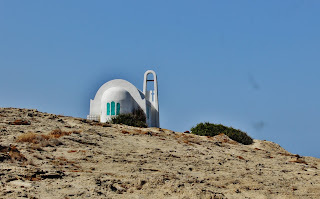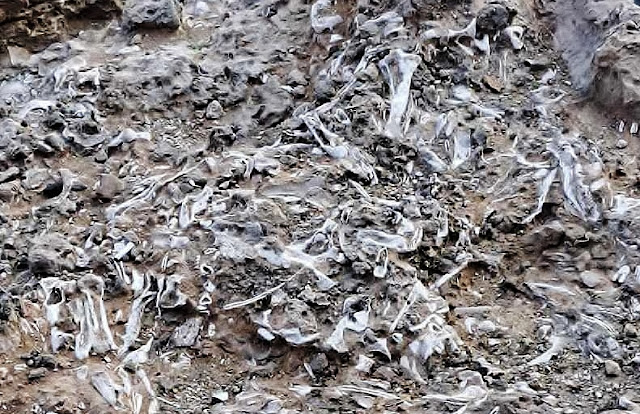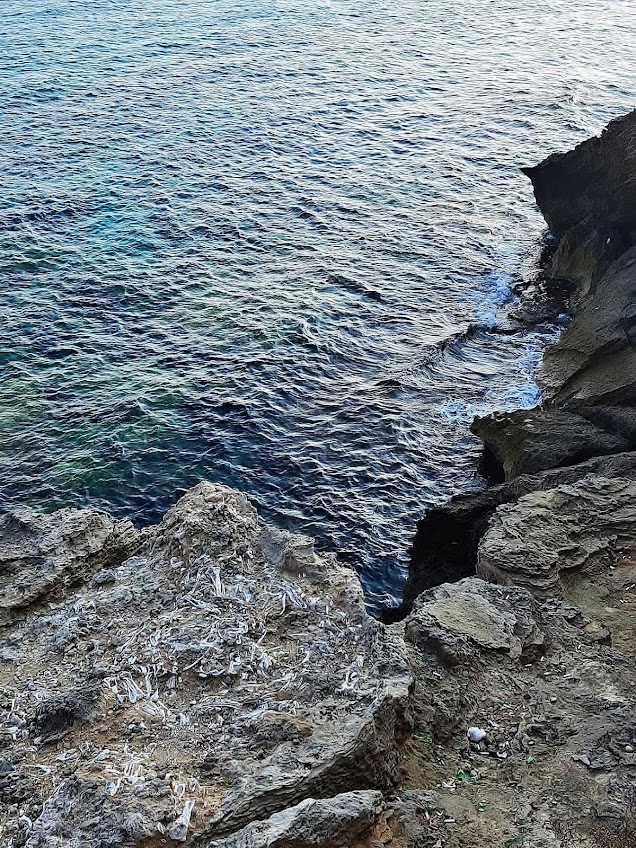
Βορειοδυτικά του χωριού, είναι η σπηλιά και το ξωκλήσι του Αγίου Φανουρίου.
Οι βράχοι γύρω και μπροστά στην είσοδο της σπηλιάς είναι γεμάτοι με τα απολιθωμένα οστά νάνων ιπποποτάμον και ελεφάντων
 Ένα άλλο παράδειγμα όπου βρέθηκαν οστά ιπποπόταμων και συνδέθηκαν με την θρησκεία είναι στον Άγιο Γεώργιο Κερύνειας όπου εκεί που βρήκαν τα οστά έκτισαν την εκκλησία του Άγιου Φανουρίου. Επίσης εκεί οι άνθρωποι έπαιρναν τα οστά νομιζόμενοι ότι ήταν οστά αγίων τα κονιορτοποιούσαν και τα έτρωγαν επειδή πίστευαν ότι είχαν θαυματουργές ιαματικές ιδιότητες. Λίγα μέτρα από την εκκλησία υπάρχει μικρή σπηλιά όπου βρέθηκαν τα οστά και χρησιμοποιείτε επίσης ως εκκλησία.
Ένα άλλο παράδειγμα όπου βρέθηκαν οστά ιπποπόταμων και συνδέθηκαν με την θρησκεία είναι στον Άγιο Γεώργιο Κερύνειας όπου εκεί που βρήκαν τα οστά έκτισαν την εκκλησία του Άγιου Φανουρίου. Επίσης εκεί οι άνθρωποι έπαιρναν τα οστά νομιζόμενοι ότι ήταν οστά αγίων τα κονιορτοποιούσαν και τα έτρωγαν επειδή πίστευαν ότι είχαν θαυματουργές ιαματικές ιδιότητες. Λίγα μέτρα από την εκκλησία υπάρχει μικρή σπηλιά όπου βρέθηκαν τα οστά και χρησιμοποιείτε επίσης ως εκκλησία.Σε άλλες περιπτώσεις, τα απολιθώματα των ζώων αυτών αποδόθηκαν σε υπολείμματα δρακόντων, γι’ αυτό και προέκυψαν τοπωνύμια, όπως Δρακοντόσπηλιος, Δρακοντότρυπα, Δρακοντοβούναρο, η Σπηλιά του Δράκου.
The Cyprus dwarf hippopotamus or Cypriot pygmy hippopotamus (Hippopotamus minor) is an extinct species of hippopotamus that inhabited the island of Cyprus until the early Holocene.

The 200-kilogram (440-lb) Cyprus dwarf hippo was roughly the same size as the extant pygmy hippopotamus. Unlike the modern pygmy hippo, the Cyprus dwarf became small through the process of insular dwarfism. This same process is believed to cause the dwarfism found in some dwarf elephants, the pygmy mammoth, and Homo floresiensis. The animal is estimated to have measured 76 cm tall and 121 cm long.
 H. minor is the smallest hippopotamus of all known insular hippopotamuses. The extremely small size of the hippo is in favour of a Middle Pleistocene or perhaps even Early Pleistocene colonization. At the time of its extinction between 11,000 and 9,000 years ago, the Cyprus dwarf hippo was the largest animal on the island of Cyprus. It was a herbivore and had no natural predators.
H. minor is the smallest hippopotamus of all known insular hippopotamuses. The extremely small size of the hippo is in favour of a Middle Pleistocene or perhaps even Early Pleistocene colonization. At the time of its extinction between 11,000 and 9,000 years ago, the Cyprus dwarf hippo was the largest animal on the island of Cyprus. It was a herbivore and had no natural predators. Excavation sites on Cyprus, particularly Aetokremnos, provide evidence that the Cyprus dwarf hippo may have encountered and been driven to extinction by the early human residents of Cyprus.
Excavation sites on Cyprus, particularly Aetokremnos, provide evidence that the Cyprus dwarf hippo may have encountered and been driven to extinction by the early human residents of Cyprus.A similar species of hippo, the Cretan dwarf hippopotamus (Hippopotamus creutzburgi) existed on the island of Crete, but became extinct during the Pleistocene.
Alternative name
Many scientists maintain the name Phanourios minor for the Cypriot dwarf hippo. This generic name was given by Paul Sondaar and Bert Boekschoten in 1972, based on the remains from Agios Georgios, Cyprus. At the site, a chapel had been built into the fossiliferous rocks. The rock strata here are very rich in bone content (bone breccia). For centuries, as already mentioned by Bordone in the 16th century, villagers have gone there to collect these bones, which in their opinion are holy, because they are the petrified remains of Saint Fanourios (see also Phanourios (saint)), a Greek Orthodox Saint who, according to local myth, had fled from Syria to escape his persecutors, but had been stranded on the hostile rocky coast of Cyprus. The collected bones are ground into a powder believed to have medicinal powers. To honour the local tradition and to refer to the site, Sondaar and Boekschoten named their new genus Phanourios, following the Greek spelling. They gave the specific name minutus, but this was later changed to minor following rules of priority.
From https://en.wikipedia.org/wiki/Cyprus_dwarf_hippopotamus
Photos 8/5/20011 by George Konstantinou


Photos 12/10/20016 by George Konstantinou
Photos 26/8/20023 by Fani Konstantinou
Dwarf hippo and elephant bones on the rocks
See also















































No comments:
Post a Comment